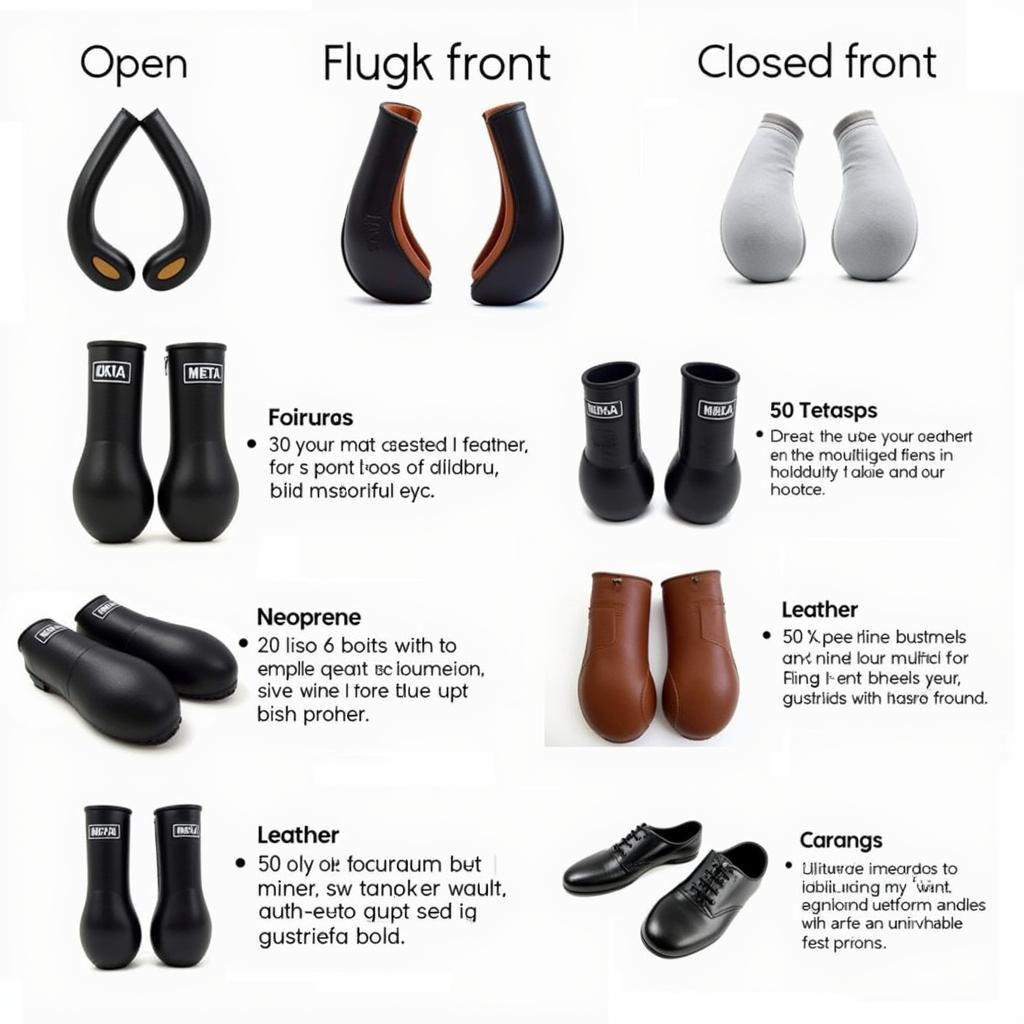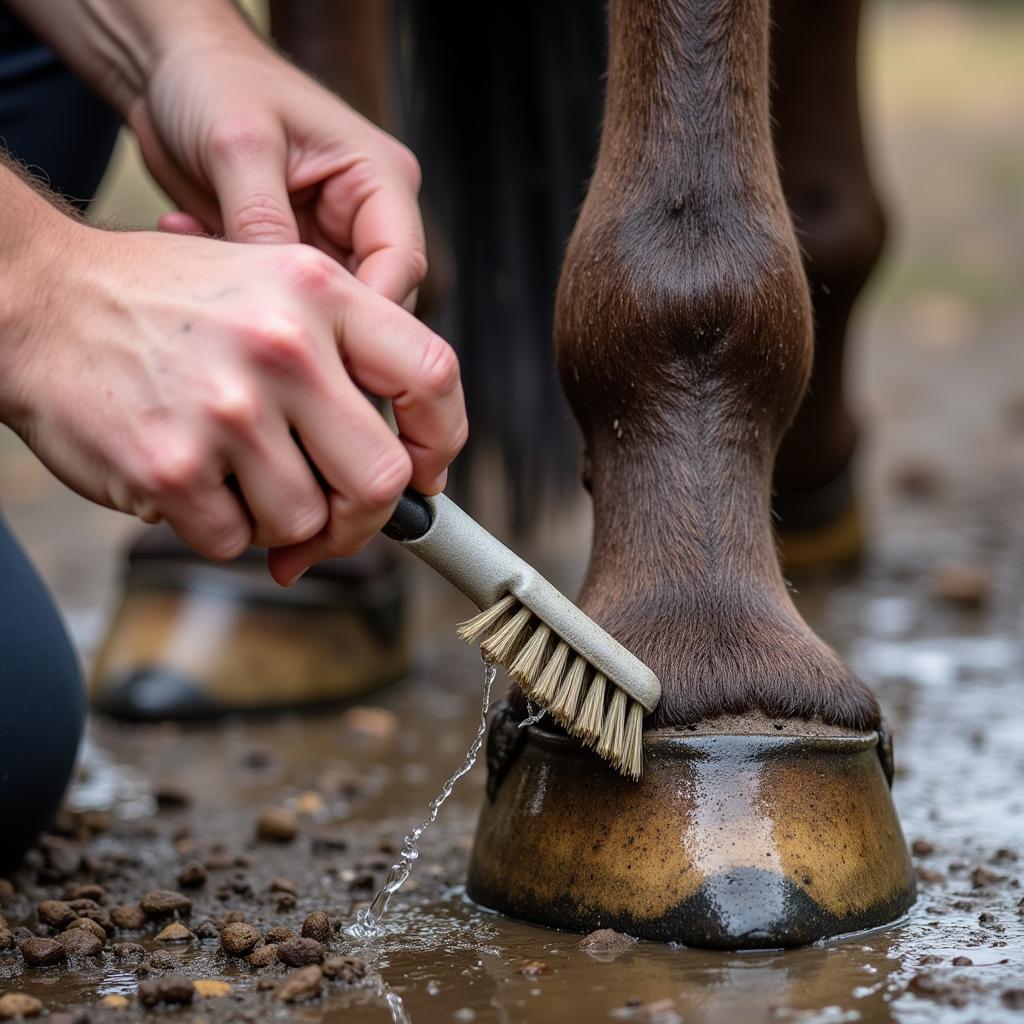Fetlock boots for horses are essential pieces of equipment designed to protect the delicate fetlock joint and surrounding tendons and ligaments from injury. Whether you’re a seasoned equestrian or a beginner, understanding the different types, benefits, and proper usage of fetlock boots is crucial for your horse’s well-being. This guide will delve into everything you need to know about fetlock boots, helping you make informed decisions to keep your equine partner safe and sound.
Why Are Fetlock Boots Important?
The fetlock joint, located between the cannon bone and pastern, is highly susceptible to impact, especially during strenuous activities like jumping, cross-country, and even everyday riding. Fetlock boots provide a protective barrier, shielding this vulnerable area from strikes, brushes, and overextension. They also offer support to the tendons and ligaments, reducing the risk of strains and sprains.
Imagine your horse cantering across a field, effortlessly clearing a small jump. Without fetlock boots, the risk of striking a fetlock during landing increases significantly. Even a minor knock can lead to painful injuries and extended periods of rest. Fetlock boots minimize this risk, providing peace of mind for both horse and rider.
Types of Fetlock Boots
A variety of fetlock boots are available, each designed for specific disciplines and levels of protection. Choosing the right type depends on your horse’s needs and the activities you engage in.
- Open Front Boots: These boots offer protection to the back and sides of the fetlock, allowing for greater freedom of movement. They are ideal for activities like dressage and flatwork.
- Closed Front Boots: These boots provide comprehensive protection, enclosing the entire fetlock joint. They are typically used for jumping and cross-country, offering superior protection against strikes.
- Neoprene Boots: These boots are known for their shock-absorbing properties, making them excellent for strenuous activities. They are also durable and easy to clean.
- Leather Boots: Traditional and stylish, leather boots offer good protection and can be a smart choice for competition. They require more care and maintenance than neoprene boots.
Selecting the right boots can feel overwhelming, but remember to prioritize your horse’s specific needs and discipline. For instance, you might consider horse jumping boots for show jumping activities.
 Different Styles of Fetlock Boots
Different Styles of Fetlock Boots
How to Choose the Right Fetlock Boots
Finding the perfect fit is crucial for maximizing protection and preventing discomfort. Fetlock boots that are too loose can slip and become ineffective, while boots that are too tight can restrict blood flow and cause chafing.
Here are some tips for choosing the right fetlock boots:
- Measure your horse’s fetlock: Use a flexible tape measure to determine the circumference of the fetlock joint.
- Consult the manufacturer’s size chart: Each brand has its own sizing guidelines, so it’s important to check the chart before purchasing.
- Consider the discipline: Choose boots designed for your specific discipline, ensuring adequate protection and support.
- Check for proper fit: The boots should fit snugly but not tightly, allowing for comfortable movement. There should be enough room to insert two fingers between the boot and the fetlock.
Remember, even within specific disciplines, there are variations. For example, cross country horse boots provide different levels of protection compared to those used in dressage.
Caring for Fetlock Boots
Proper maintenance extends the life of your fetlock boots and ensures they continue to provide optimal protection. After each use, remove any dirt and debris with a brush or damp cloth. Allow the boots to air dry completely before storing them in a clean, dry place. Inspect the boots regularly for signs of wear and tear, replacing them as needed.
Keeping your boots clean not only extends their life but also prevents the buildup of bacteria and dirt that can irritate your horse’s skin. This is particularly important for horses with sensitive skin.
Dr. Emily Carter, DVM, Equine Sports Medicine Specialist, emphasizes, “Regular cleaning and inspection of fetlock boots are essential for preventing infection and ensuring optimal performance. A small investment of time can save you significant veterinary costs in the long run.”
 Cleaning Horse Fetlock Boots
Cleaning Horse Fetlock Boots
Conclusion: Protecting Your Horse’s Fetlock with the Right Boots
Fetlock boots are a vital piece of equipment for protecting your horse’s delicate fetlock joints. By understanding the different types, choosing the right fit, and providing proper care, you can ensure your horse’s comfort, safety, and peak performance. Investing in high-quality fetlock boots is an investment in your horse’s long-term health and well-being. Don’t forget to check out options like grab boots horse or even veredus horse boots for added protection and support.
FAQ
-
How often should I replace my horse’s fetlock boots? Replace fetlock boots when they show signs of wear and tear, such as cracks, tears, or significant thinning.
-
Can I use fetlock boots on all four legs? Yes, fetlock boots can be used on both front and hind legs, offering protection and support. Consider horse hind boots for specialized hind leg protection.
-
What are the benefits of using fetlock boots? Fetlock boots protect the fetlock joint from strikes, brushes, and overextension, reducing the risk of injury.
-
How do I measure my horse for fetlock boots? Use a flexible tape measure to determine the circumference of the fetlock joint, and consult the manufacturer’s size chart.
-
What materials are fetlock boots made of? Fetlock boots are commonly made of neoprene, leather, or synthetic materials.
-
Are fetlock boots necessary for all disciplines? While not strictly necessary for all disciplines, fetlock boots provide valuable protection and support, especially during strenuous activities.
-
How do I clean my horse’s fetlock boots? Clean your horse’s fetlock boots after each use with a brush and water, allowing them to air dry completely before storing.
Other Related Topics
You might also be interested in learning more about other types of protective horse boots, such as tendon boots and bell boots. These provide additional protection for different areas of your horse’s legs.
Need support? Contact us at Phone: 0772127271, Email: [email protected] or visit us at QGM2+WX2, Vị Trung, Vị Thuỷ, Hậu Giang, Việt Nam. Our customer service team is available 24/7.